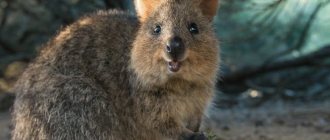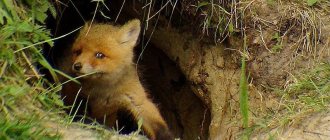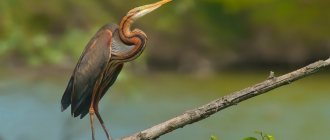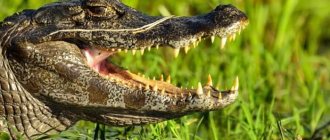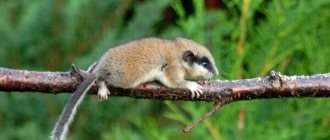Lizards belong to the squamate family, which is part of the suborder of reptiles. They are the oldest representatives of fauna on Earth, since their existence coincides with those distant times when dinosaurs lived on the planet. In addition, even the word “dinosaur” is translated from Latin as “large lizard.” At the same time, truly large representatives of lizards, as well as dinosaurs, disappeared from the face of the Earth. However, their smaller relatives survived and successfully adapted to the conditions around them, due to which they are still considered extremely common reptiles, found everywhere.
general characteristics
Lizards are considered representatives of a separate evolutionary lineage, despite their close relationship with snakes. In fact, lizards are considered direct descendants of snakes, but this does not prevent them from being separated into a separate branch of development. Like snakes, lizards belong to the squamate order. At the same time, lizards are considered representatives of different evolutionary groups, despite the unification based on the presence of certain features of physiological development, for example, the possibility of losing limbs.
All lizards have movable eyelids and visible openings that represent ear canals. Most lizards have two pairs of limbs, but this does not always characterize all representatives included in this suborder. To determine whether reptiles can be classified as lizards, the internal structure of the body is usually assessed.
Most lizards have a rudimentary sternum and shoulder girdle, which is absent in snakes.
There is a wide variety of variations in the appearance of lizards. Their background color is directly related to the need to camouflage among the natural conditions of the landscape, which determines the presence of different options for the natural color of lizards. The most common are the varieties in which the color is green, gray, brown, or sand.
Lizards are characterized by the presence of various spots, stripes and stains, which can sometimes form bizarre geometric shapes. Some representatives of the species can change color based on the situation. Mimicry based on color changes is common among lizards.
Lizards can also have distinctive colors like the Tokay gecko.
The scales of lizards are located differently and depend on the species of reptile. Thus, the arrangement of scales can be overlapping, in the form of a tiled roof, end-to-end, etc. Often the scales are formed in the form of peculiar spikes. In some lizards, the scales acquire especially durable properties due to the osteoderm - bony plates located inside the horny scales.
Lizards' mouths are filled with teeth. In some reptiles, certain types of teeth are located near the palate. Pleurodont teeth are teeth that change periodically, which is why they are not fixed too firmly. Acrodont teeth are permanent; they are firmly located in the mouth due to the fact that they are fused with the bones. This type of teeth is characteristic of a small number of lizards.
The bristles are quite thin, thanks to which reptiles can freely stick to different surfaces, including fairly smooth ones.
The limbs of reptiles are formed in different ways: their structure depends on the natural living conditions. For example, lizards, which require the ability to quickly climb various surfaces, have tenacious fingers due to the presence of bristles on the pads.
The tongue of lizards also differs in shape and size. Moreover, in all representatives of the suborder it is quite flexible, mobile and freely protrudes from the mouth.
Some reptiles can even catch fish using the flexibility and strength of their tongue.
The main weapon of lizards, however, remains their teeth. With their help, they grab prey and cut it up. For example, a monitor lizard with its sharp teeth can actually cut its prey into pieces. In addition, the suborder of lizards also includes one poisonous representative, the venomtooth, which is capable of transmitting poison to the victim along with its bite, which ultimately helps them cope with the enemy.
Poll: Have you ever held lizards in your hands?
Yes, I did
62.5%
No, I didn't hold it
37.5%
Voted: 8
Difference from snakes
Those types of lizards that do not have legs are almost the same in appearance as snakes. Such lizards include, for example, the copperhead, which many take for a snake, although in fact it is a lizard that simply does not have legs. But how can one distinguish such a legless lizard from real snakes?
Where do lizards live?
Lizards can be found everywhere, as they live in all corners of the Earth, excluding Antarctica. These reptiles settled throughout Asia and Europe, starting from the Arctic Circle, where the climate is moderated by the presence of warm ocean currents. At the same time, lizards prefer warm climates. Most often they are found in steppes, meadows, forests and deserts located in any part of the world.
Lizards can also be found at altitudes different in relation to sea level. For example, in the Himalayas, reptiles live at an altitude of up to 5 km above sea level. They do well in rocky and mountainous areas. The reptiles common in Russia are among the true lizards, which can be found almost everywhere: in fields, gardens, mountains, near water bodies.
Helmeted Basilisk in water
Each type of lizard is characterized by the ability to quickly move across various surfaces, deftly holding on to various bulges and irregularities. For example, rock species of lizards can not only move deftly through the mountains, but also make long jumps of up to 4 meters.
Elena
Ask a Question
Question to the expert
What is the lifespan of lizards?
The average lifespan of lizards varies depending on their species and size. So, for example, for small reptiles this figure is 1-3 years, while large iguanas and monitor lizards can live more than 50 years. In captivity, lizards can live up to 20-30 years.
Orders of reptiles
Biologists divide all lizards into 6 orders, each of which includes about thirty families. The orders of reptiles are:
- Skink-like. The order is distinguished by rich species diversity. It includes real lizards, widely represented in Russia, but most species live in tropical areas of the planet. Skink-like reptiles are found in South America and Africa, Madagascar and Cuba. Some varieties were discovered by scientists in the Sahara Desert.
- Iguanas. This order includes 14 families of reptiles. The most famous of these is the chameleon, found in South America and Madagascar.
- Gecko-like. Reptiles belonging to this order are considered rare. It includes lizards that do not have legs. They are found in Australia.
- Fusiform. These include monitor lizards.
- Worm-like lizards. These are the so-called scale insects. Externally, reptiles look more like huge earthworms. They can be found in the tropical rainforests of Indochina, Indonesia and Mexico.
- Monitor lizards. These lizards are very large. Their weight often exceeds 5 kg. There are a lot of legends about them.
There is only one type of poisonous lizard - the poisonous lizard. When attacking their prey, they not only bite it, but also inject dangerous poison under the skin.
Some species can be pets
Kinds
Currently, scientists identify about 7 thousand species of lizards, united in more than 30 families and 7 independent suborders. Among the most notable families of reptiles are the following.
Agamidae
These are lizards that prefer to lead a diurnal lifestyle and are of medium size. However, among them there are sometimes very tiny individuals. They live in Eurasia, Africa and Australia. They can be found almost everywhere, with the exception of extremely cold areas. Agama lizards can be land-dwelling, water-dwelling, tree-dwelling, or burrow-dwelling.
The most notable representatives of the family include the following lizards:
Spiketails
They live in northern Africa, India and Pakistan. They have a wide body, the size of which can reach up to 75 cm. The head is slightly flattened, the tail is thick and has spikes, which determines the name of the species. The color of the spiketails resembles dark sand or clay in appearance.
Frilled lizards
These species live in Australia and New Guinea. In this area, all names associated with frilled lizards include the word "dragon", such as tropical dragon or bearded dragon (lizards may have darkened lower jaws due to stress, becoming beard-like). Frilled lizards have a menacing appearance due to a collar-shaped fold that can rise in moments of excitement. The red-terracotta color, sharp claws and teeth create a threatening impression and repeat the appearance of the “dragon”.
Spiny Devil
The lizards received this name in honor of the pagan deity, to whom people made human sacrifices for a long time. The lizard's body is completely covered with curved spines. Those located above the eyes resemble horns in appearance. Like chameleons, the spiny devil can change color to suit its mood. The lizard's body size is approximately 20 cm.
Water dragons
These are lizards that live in Southeast Asia, China, Cambodia, etc. From Greek, their name can be translated as “swollen jaw,” but in the modern world they are better known as “water dragons.” This is due to their ability to stay underwater for a long time and use their tail for swimming. Such individuals are considered a fairly popular species for home keeping.
Chameleons
Chameleons are characterized primarily by their unique ability to change body color, which is due to the special properties of their skin. The skin contains various colored pigments that are located in chromatophore cells. In addition, the refraction of light on the skin, which contains guanine, adds color diversity to chameleons.
The standard body length of these reptiles does not exceed 30 cm. However, there are really large chameleons that can reach a size of 50 cm. Africa, the Middle East, and the southern part of Europe become characteristic habitats for chameleons. Yemen and panther chameleons are often chosen for home keeping.
Iguanas
Lizards live in America and are found in the Caribbean and Galapagos. The largest among them are considered true iguanas, capable of growing up to 2 meters in length. They are characterized by the presence of pleurodotic teeth attached to the jaw bones. Moreover, unlike acrodont teeth, fallen pleurodont teeth can eventually be restored.
Collared
Representatives of this species are considered to be inhabitants of North America. They do not have most of the characteristic features of the infraorder Iguanaiformes. For example, collared lizards lack a longitudinal stripe on the back, a throat pouch, and scales in the ears and fingers. The presence of such significant branches led to the decision to allocate collared chameleons into a separate family, separating it from the iguanas. A characteristic feature of this species is the presence of a bright collar, due to which the lizards received their name.
Masks
This is a peculiar monotypic family living in the eastern part of India, and is also found in Florida. Masked lizards can twist their tail into a spiral. They got their name due to the wide black stripe that runs from the nose to the eyes, which resembles a kind of mask. A typical representative of the family is the masked iguana, which can be seen in Haiti.
Anolis
Representatives of this species live in America, as well as in the Caribbean. They have a rather small and slender body that looks like young grass. All lizards have rather long fingers. Males have a throat pouch, which they use during the mating season to attract females or in times of danger to scare away the enemy. Anole lizards are characterized by the ability to change color.
Corytophanidae
Lizards live in the central part of North America, as well as in the territories of South America. They have a different, more “popular” name - helmet, which is due to the specific structure of the lizards’ head. Corytophanids are capable of developing good running speeds - up to 12 km/h.
Gecko
Geckos differ from other lizards by their specific karyotype and the presence of a characteristic muscle in the ear area. They lack bony temporal arches. Also, a significant part of geckos have tenacious and rather long fingers, on which small hairs are located. This anatomical feature allows you to easily move on various vertical surfaces.
Difference from newts
Also, sometimes lizards are confused with newts, and, of course, they have a lot in common: similar structure of paws and body, snake-like head, long rounded tail, movable eyelids and much more. But there are still a number of differences between it:
- The most important difference is the different structure of the skin; if lizards have scaly skin, then in newts it is completely smooth and slimy to the touch.
- Newts do not know how to throw off their tail, while lizards easily and simply get rid of this part of their body in case of danger.
- Lizards have a hard and ossified skull, while newts have a cartilaginous skull.
- While lizards breathe exclusively through their lungs, newts are able to breathe through both their lungs and gills, and even through their skin.
- If lizards reproduce by laying eggs, then newts conduct their reproduction process like fish - in water and through spawning.
What do lizards eat?
Lizards are among the carnivorous reptiles. They usually eat invertebrates, insects, mollusks, worms, spiders, etc. Small lizards can hunt butterflies, grasshoppers, and snails. Large lizards are capable of hunting mice, frogs, snakes, other lizards, amphibians and birds.
Lizards often eat bird eggs, destroying bird nests.
The largest members of the family, like the Komodo dragon, which is considered the largest lizard on Earth, are capable of attacking a large opponent like a wild pig or deer.
Some members of the family are stenophages, that is, they have a highly specialized diet. For example, molochs eat exclusively ants, and pink-tongued skinks eat terrestrial mollusks.
Among the representatives of the family there are also herbivorous reptiles, whose diet consists of plant shoots, leaves or fruits. Based on age, the diet can also be supplemented with insects, but as they grow older, reptiles become vegetarians.
There are also omnivorous varieties that have no problems with choosing a diet in principle. They are able to eat anything that comes their way, regardless of whether it is plant or animal food.
These species include the Madagascar gecko, whose diet is based on insects, plant fruits, and pollen.
During a hunt, lizards try to sneak up on their prey unnoticed, and then make a swift dash in which they overtake the victim, clinging to them with their teeth and claws. This is their main weapon when confronting opponents, but some members of the family also use the tongue for hunting.
Chameleons
These lizards have a bright appearance that will make them a real decoration. In addition, they easily get used to people, are unpretentious, and rarely get sick, which makes them a popular choice for keeping in the home.
Features of character and lifestyle
Typically, lizards are characterized by a terrestrial lifestyle, but some species prefer to climb various vegetation and live in trees, while others prefer to bury themselves in the sand. Some lizards, like geckos and agamas, are skilled at moving on smooth surfaces, which is why they are often found among rocks.
Some representatives of reptiles are capable of gliding in flight, due to which they thus move from one tree to another.
There are lizards that have a rather long body and prefer to live in the soil. For example, the sea lizard chooses to live on the coast and often appears in the sea.
All reptiles differ in their activity schedules: for some, the daytime lifestyle is considered more common, while for others it is night or twilight. Most of the predators are diurnal, going out to hunt as dawn approaches. Reptiles are cold-blooded, which is why they do not tolerate temperature changes well. The rays of the scorching sun, from which they have to hide in the shade of vegetation, are also not suitable for their skin.
Some members of the family have a “third eye” located in the parietal region. Despite its inability to distinguish shapes, it is good at detecting light levels. Also, such a “third eye” is characterized by the ability to regulate the duration of exposure to the sun due to sensitive perception of the influence of ultraviolet rays.
Lizards have a calm character: they prefer not to enter into fights or alliances. Most of all, they like a solitary life without contact even with their relatives. The only time when lizards can come together is the mating season. Moreover, such contacts are not limited only to the need to conceive offspring. Thus, males wage fierce battles among themselves for the possibility of possessing a female and territory.
Question to the expert
How do lizards winter in the wild?
With the arrival of cold weather, the body temperature of reptiles begins to decrease, making it difficult to obtain food, which forces the lizards to reduce their natural activity. Lizards spend the winter in the same way as other animals by hibernating. However, they do this not like ordinary reptiles, but rather like squirrels or birds. Thus, lizards collect dry branches and leaves, from which they subsequently build their own nest. Preparation for wintering begins at the end of September and lasts until mid-October. They usually create burrows themselves, placing them close to tree roots and old stumps. In the absence of such an opportunity on the landscape, reptiles are engaged in digging holes on their own at a depth of 15-20 cm underground. In addition, they can adapt rodent burrows, cracks in the ground, summer cottages, etc. for their purposes. The main thing is that the hole is warm and dry enough. At the same time, unlike other animals, lizards can quickly switch to an active lifestyle, so terrarium lovers are not always able to observe the classic hibernation of their pets.
Interesting Facts
- Basilisk lizards are able to move on water. And this is not a biblical miracle, but a physical law of nature; movement through the water is achieved by quickly and very often moving the lizard’s hind limbs.
- Lizards, like many other animals, are color blind, but unlike many of them, who see the world around them in black and white, lizards look at it through orange glasses in the most literal sense - they see the whole world as different shades of orange.
- Colombian gourmets consider the eggs of some lizards to be the greatest delicacy. There they even specially catch pregnant female monitor lizards and iguanas, cut their belly, take out the eggs, rub wood ash into the wound itself, after which the female is released, and the eggs end up on the dinner table.
Lizard Reproduction
The mating season for lizards falls in late spring or early summer. Larger members of the family breed once a year, smaller ones - several times in one season. If there are several contenders for a female, the largest one wins. He can win even without fighting, since smaller males prefer not to fight a potentially dangerous opponent. Moreover, if the males are similar in size, competitors can engage in a fight, during which they exchange furious bites. After the fight, the female goes to the winner.
Lizards, depending on the variety, can reproduce through oviparity, ovoviviparity, or direct viviparity. However, regardless of this, reptiles are considered to be mostly oviparous reptiles.
After fertilization, the female begins laying eggs. Small lizards can lay about 4 eggs; larger representatives of the species can lay up to 18 eggs in one pregnancy. Eggs vary in size.
So, round-toed geckos, which themselves are quite small, will have eggs no more than a couple of millimeters in length. Komodo dragon eggs can reach 10 cm in length.
Recommended by topic
Monitor lizards Chameleon Turtle
Females take care of their clutches, choosing the most secluded burrow or cave to place them. These can be caves or burrows. The incubation period lasts at least 3 weeks, and sometimes can reach 1.5 months, after which babies are born. Newborns immediately learn to independently adapt and adapt to the conditions of the surrounding world, since parents no longer show concern for their offspring.
South American skinks are called the only lizards that belong to viviparous species. Their eggs without yolks are formed in oviducts specially adapted for this, and all nutrition enters the body of the developing cubs through the placenta. The organs are positioned so that the blood vessels of the mother and the babies are united.
Lizards also reach sexual maturity in different ways, depending on the species. For small reptiles, this moment occurs a year after birth. For large ones - in a few years.
How to distinguish a male from a female?
Male and female lizards look almost the same, although there are a number of signs by which the sex of the lizard can be determined.
- In some species of lizards, such as basilisks and greens
iguanas, males have a bright crest on their back.
In general, all methods for determining the sex of a lizard are not perfect, and you can find out for sure whether it is a boy or a girl only through a testosterone test of the lizard’s blood done in a professional veterinary clinic.
Natural enemies
Lizards, especially small ones, have a significant number of natural enemies due to their small size and the almost complete absence of defense mechanisms. Therefore, nature took care of reptiles, giving them the opportunity to defend themselves from enemies by dropping their tail, which remains in the hands or teeth of the enemy. After it is dropped, the lizard successfully slips out of the grip and hurries to run away as far as possible.
Moreover, each lizard has its own unique defense mechanisms, which differ depending on the species. For example, long-eared roundheads are capable of spreading their limbs wide and tensing their body, which together creates a terrifying pose when colliding with an enemy. If this fails to scare off an enemy, the lizard may use its teeth and claws in open combat.
Among the most characteristic enemies of lizards are the following:
Birds of prey like hawks, owls or eagles.
- Foxes.
- The Bears.
- Wolves.
- Snakes.
Sometimes even their own relatives, who do not mind feasting on smaller lizards, become a problem.
Video
Author: Pavel Chaika, editor-in-chief of Poznavaika magazine
When writing the article, I tried to make it as interesting, useful and high-quality as possible. I would be grateful for any feedback and constructive criticism in the form of comments on the article. You can also write your wish/question/suggestion to my email [email protected] or Facebook, with respect, the author.
Author page
This article is available in English - Lizard.
